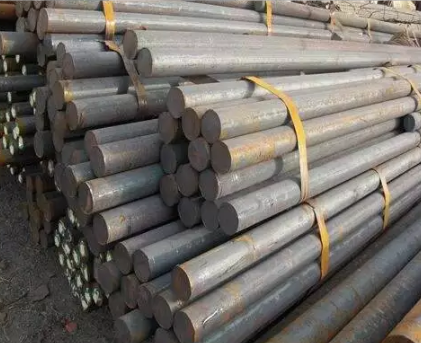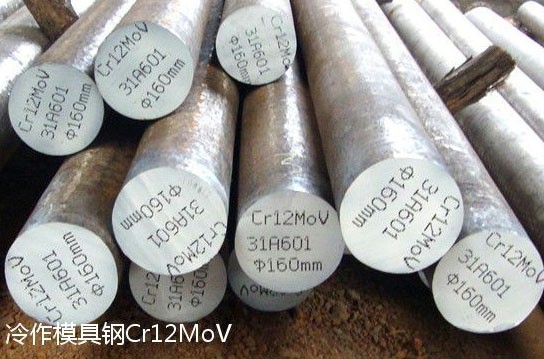Effect and Properties of Cr12MoV Cold Working Die Steel
From: Author:ss@solarsteel.cn Publish time:2021-08-26 09:34 Clicks:50
Effect and Properties of Cr12MoV Cold Working Die Steel
Cr12MoV cold working die steel belongs to high wear-resistant and micro-deformation tooling steel, which it is characterized by high wear resistance, harden ability, micro-deformation, high thermal stability, high bending strength and other properties.

It is second only to high speed steel, and it is an important material for stamping dies and cold heading dies.
Cr12MoV die steel is carbon molybdenum lay steel which has the carbon content is lower than CrL2 steel.

And it add the content of molybdenum and vanadium to make the steel ability of hot working property, impact toughness and carbide distribution have improved obviously.
The Cr12MoVsteel ‘s carbon content is lower than the Cr12 steel. It adds the new alloying element in to improves the phenomenon of uneven carbide and Mo element can reduce carbide segregation and improve harden ability, and V element can refine grain size and increase toughness.
Therefore ,Cr12MoV steel has very high harden ability. The cross section of Cr12MoV can be completely quenched under 400 mm. It can still maintain good hardness and wear resistance at 300~400℃.
In addition,Cr12MoV steel have better toughness than comparable materials in the general market, and the possibility to reduce the volume’ changing of material during quenching process .
Therefore, the high wear resistance and good comprehensive mechanical properties make the Cr12MoV die steel more suitable for the manufacture of various dies with large cross section, complex shape and greater impact, as well as a variety of cold stamping tools under heavy working conditions
For example: punching die, trimming die, rolling die, steel plate deep drawing die, circular saws, standard tools and measuring tools, thread rolling die, etc.
Application Guidance Cases for your reference only as below :
① Cr12MoV can be used to make the blanking die with thickness more than 3mm , for example Convex touches, concave touches, inserts of complex shapes, it is recommended that the hardness be 58~62HRC when making convex touch and 60 ~64HRC when making concave die.
② It is used for making punch and concave touch which require high wear resistance in punching die. The recommended hardness is 60~62HRC when making punch, and 62~64HRC when making concave die.
③ Used for making the wear resistant die in the deep drawing die, the recommended hardness is 62 ~64HRC.
④ Used for making punch, die and inserts which require high wear resistance and complex shape in bending die. It is recommended that the hardness be 60~64HRC when making punch and 60~64HRC when making concave die.
⑤ It is recommended that the hardness be 60~62HRC when making punch, and 62-64HRC when making concave die.
⑥ For the punch and concave die of cold extrusion die of copper parts, the hardness is recommended to be 62~64HRC.
⑦ For punch and concave die of cold extrusion die of steel parts, it is suggested that the hardness should be 62~64HRC.
⑧ The spring steel plate used to form the mass fraction of carbon is 0.65% ~0.80%, the hardness is 37 ~42HRC, the service life can reach 150,000 times.
⑨ The spring steel plate used to form the mass fraction of carbon is 0.65%~0.80%, the hardness is 37~42HRC, and the additional nitriding treatment, the service life can reach 400,000 times.
⑩ The steel is used for rubbing wire touch, such as the use of simple forging, carbide unevenness of 5 ~6 level, rubbing die service life is very short, easy to drop teeth.But when the use of multi-direction forging process to reduce the carbide non-uniformity to not less than 2 levels, the service life of the wire board will be increased from thousands of pieces before to 20,000 pieces, or even up to 500,000 pieces.
Processing:
Specification for soft touch blank of cold extrusion: use raw iron scraps to protect and heat with the temperature 760-780℃, time for 10 hours, furnace cold, hardness 196HBW, can realize cold extrusion forming smoothly.
General isothermal spheroidizing annealing specification: 850-870℃×3-4 hours, with furnace cooling to 740-760℃×4-5 hours in isothermal , air cooling hardness of furnace ≤ 241HBW, eutectic carbide grade ≤3, the best isothermal temperature of 740-76o℃, time ≥ 4-5 hours.
Spheridizing Annealing Specification :(860±10) ℃×2-4 hours, at a cooling rate with 30℃/ hour, (740±10)° C x4-6 hours, with the furnace slowly cooling to 500-600℃, air cooling.The hardness of 207-255 HBW.
Specification for ordinary quenching tempering: quenching temperature 1000-1050℃, oil quenching or gas quenching, hardness 260HRC, tempering temperature 160-180, tempering time 2 hours, or tempering temperature 325-375°C, tempering 2-3 times.
Low quenching and low back quenching temperature: 950℃-1040℃, tempering temperature of about 200℃, secondary tempering.
High quenching and high back quenching temperature: 1050-1100℃, tempering temperature of 520℃ or so, secondary tempering.High quenching and high return use the secondary hardening method, thus improving the hardness, but the grain size will grow largely .
Cryogenic treatment: Cr12MoV steel after cryogenic treatment, cryogenic treatment can make quenched martensite precipitate highly dispersed ultrafine carbides, and then tempering at 200℃, these ultrafine carbides can be transformed into carbides
The martensite without cryogenic treatment only precipitates a small amount of carbides in some local areas after peri-firing at low temperature.
Cr12MoV steel is treated by chemical heat treatment at low temperature. On the basis of maintaining high hardness and wear resistance of Cr12MoV steel, the three commonly used chemical heat treatment infiltration layers of ion nitriding, gas nitriding and salt bath thiocyanate have significant impact adhesion effect, and the salt bath thiocyanate co-infiltration is the best.
Finally there have many clients ask for the same question :
Does Cr12MoV steel can be replaced the steel of SKD11, D2....
Now I am answering you here .
The grades of similar imported materials: Japan SKD11 die steel, Germany 1.2601 die steel, the United States D2 die steel, etc., but it is not recommended to use domestic materials to replace imported materials, because the process is different, can not completely replace all the characteristics of imported materials.
Solar Special Steel International Limited
Email: ss@solarsteel.cn
Whatsapp /Wechat /Skype :+86 18688633122



